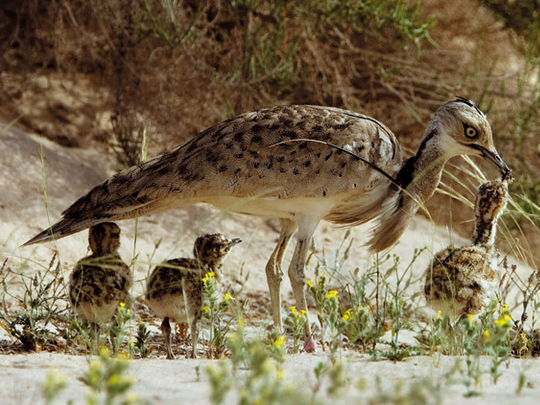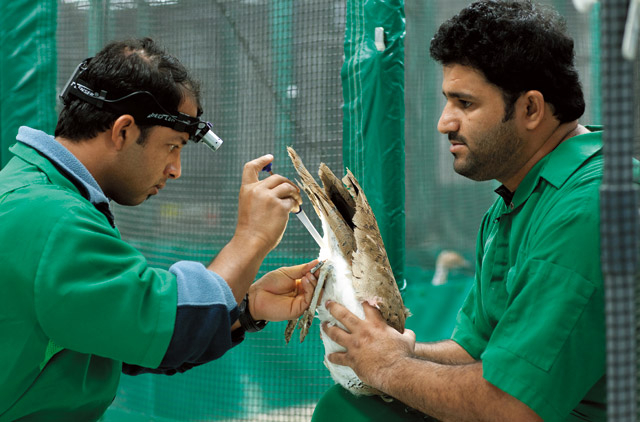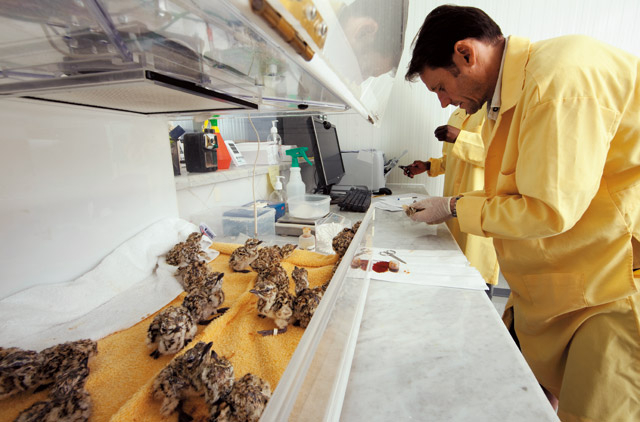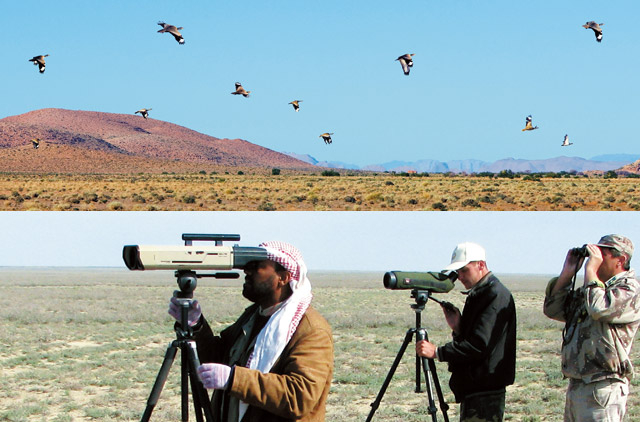
Mohammad Saleh Al Baidani, the director general of the International Fund for Houbara Conservation, an organisation that has its headquarters in Abu Dhabi, has a soft side. "Did you drive down here from Dubai? How was the weather, did you have any problems?" he inquires. A pause, and he continues: "They have predicted rain; this is just the perfect weather for houbaras to start breeding. I hope it does; it would be great!"
For Al Baidani, houbaras come first. "It's been like that since I started working in this field in 1996," he says. "In the 1980s I used to watch documentaries about falconry on television. I found them interesting, but what really intrigued me was this bird they were hunting. I knew nothing about it. It was only when I started working with National Avian Research Centre (NARC), (an integral part of International Fund for Houbara Conservation), in 1996 and visited Kazakhstan for the first time that I saw it in the wild."
In pictures: Saving the houbara bustard
Seeing it in all its glory, the way the male houbara displays its glorious plumage to the female bird, how the female leads hunters astray to save her chicks, made Al Baidani develop an abiding respect and love for the birds. "I was there only for 15 days, but I came back a convert. Even now I cannot conceive of a time when this wonderful bird will not be seen in the wild."
Why the houbara?
Why is it so important to save the houbara? Apart from being an important link in the food chain, the houbara is essential to the art of falconry that is so intrinsic to Arabic culture. "The future of falconry depends on the survival of the houbara," says Al Baidani. The reason is the houbara is the main quarry in falconry. It is this fervour that powers Abu Dhabi's push to save the houbara species from extinction.
"It was initiated more than 30 years ago by the late Shaikh Zayed Bin Sultan Al Nahyan when as an experienced falconer, he noticed that the number of the birds had begun to decline," explains Al Baidani. "It was always his vision to balance everything; so along with hunting, he believed that houbaras should be conserved if they were to survive in future. He used to say even then, we should not wait till this bird becomes extinct and then jump up and scramble to save it - as had happened to a number of other species. He was the one who broached the idea of breeding the houbara in the UAE."
Considering that urbanisation of the UAE (which meant the houbaras habitats may be destroyed) and increase in poaching was a mere glimmer in the horizon at that time, Shaikh Zayed's vision was exemplary. What he foresaw then did happen decades later, but his back-up plan was already in place.
Stage one: understanding the need for captive-breeding
The first effort to start breeding this bird was initiated in the Al Ain Zoo 30 years ago with a group of birds that came from different countries. "The programme succeeded, with the hatching of the first chick in 1982," says Al Baidani. Considering it was the first time something like this was being attempted in this country, it was an enormous achievement.
This gave them the impetus to establish a centre where breeding could be carried on in a more scientific manner. Thus NARC was established in Sweihan in 1989. "It started functioning in 1993 and focussed only on the Asian houbara species, which migrates here from central and north east Asia in winter," says Al Baidani.
NARC started its breeding programme with some birds handed over from private collections. "It was not the ideal thing to do; you have to start with birds that are hatched in captivity because of the many parameters you have to consider in captive breeding," agrees Al Baidani. "But we had to start somewhere and along the way we refined our techniques, determining the best way to design the buildings, maintaining the right temperature, and so on for breeding."
NARC scored its first major success in 2001. "After that every year the numbers started to increase. Last year, we had more than 4,800 chicks hatched between two centres." NARC has grown to the point where it has set a target of hatching 5,000 birds every year.
The International Fund for Houbara Conservation (IFHC) was established in 2006. This fund was formed as an umbrella for the existing centres and to coordinate the efforts of the UAE government for the conservation of houbaras.
The success of the Fund is evident when you look at the targets it sets for itself, and achieves. Right now, NARC has a target of 5,000 hatchlings a year. This is part of the total number which will serve the strategy put in place by His Highness Shaikh Khalifa Bin Zayed Al Nahyan, President of the UAE, Supreme Commander of the UAE Armed Forces and Ruler of Abu Dhabi. That target is to breed 50,000 birds every year - 35,000 Asian houbaras and 15,000 North African houbaras. "NARC should reach its target within a few years," says Al Baidani. "We are also looking at another 5,000 at a new centre, the Shaikh Khalifa Houbara Breeding Centre, that is being built not far from NARC. So, when we reach our target, Abu Dhabi alone will be hatching 10,000 houbara chicks every year. The first phase of the facility will be ready by the end of this year."
The numbers may not say the entire story, however. Houbaras are notoriously difficult birds to breed in captivity, and it is nothing short of a miracle that IFHC has been able to achieve what it has in such a short span of time.
Stage two: the release of captive-bred birds
The release of captive-bred birds from NARC began on an experimental basis at the end of 2000 with five birds. "By the beginning of 2010, 800 birds had been released," says Al Baidani. "This year we will release 884 from NARC, which is more than the total number of birds released between 2004 to 2009. I would say in total 1,684 houbaras will be released by the end of this year."
The reason why the numbers excite Al Baidani so much is that there are so few of the birds left in the wild. Experts don't even want to mention figures, not that they have very firm figures. But since captive-breeding and release of the houbaras, at least bodies like the IFHC have some consolation that the numbers are increasing - and rapidly - compared to the normal breeding patterns of the bird.
However, it is not enough that the numbers increase, they have to be seen to increase - in the wild. "What use is it if we have thousands of houbaras bred at our centres?" asks Al Baidani. "They have to be let out, so they can adapt to life in the wild and perform the role they are meant to in the food chain."
There is a pattern to releasing the captive-bred houbaras, says Al Baidani.
"Close to 4,000 chicks were bred last year between the three centres we manage. But when you have a target to breed 10,000 houbaras, you don't release all your birds that are alive and healthy. You release only a partial number of them. Some of them will be retained as breeders for the future. We calculate the numbers based on the stock we have, how many males and females there are, whether the representatives of the genetic pools in the collection is balanced. Whenever there is more of a particular gene pool, we release them."
Stage three: Tracking the released birds (an amazing science!)
Once the birds are released, they are tracked via satellite and radio. "NARC began studying the Asian houbara on the breeding grounds in 1994 and this led to our first international collaboration with Kazakhstan to do a survey and investigate the breeding grounds there. Our first attempt at tracking the birds too started at this point. We also expanded our international collaborations by signing agreements with China, Mongolia, Oman, Yemen, and Saudi Arabia, with most of the registered countries in fact."
Only a percentage of the birds released are tagged with transmitters. "This gives us a fair indication of their movements that is representative of the rest of the birds," says Al Baidani. "We began this in the UAE in 2004. The idea initially was to see if they could survive the heat, the harsh conditions, and if they would move. But the results exceeded our expectations. We found some were breeding here. We found their nests and chicks."
Tagging gave a fair indication of the survival rate of the released houbaras. "The survival rate is now between 65 and 70 per cent, which I feel is an excellent result. We usually take stock after a year, and if it has survived that means it has adapted to the wild, and its chances of breeding greater."
With new technology, IFHC is able to track the birds for more than six years now. "In the beginning it was less than a year," says Al Baidani. "Now, not only do the batteries last very long, the size and the weight of the transmitters have decreased, to around 30g, so it is much better and more accurate with inbuilt GPS. You can now track a bird to within 20m to 25m of its actual position. So, sitting in Sweihan (where NARC is located) you can find out if the female houbara has laid an egg in Kazakhstan, or whether she's sitting in her nest. We just have to check the bird number so-and-so with her coordinates and we have the full picture. They don't even have to go look for the bird, they can just look for the nest.
"The data also tells you whether the female is nesting, moving, how high it is flying, the temperature of its body, everything. If it is dead, you can even know how it died, whether due to natural causes or by poaching. Some transmitters remain active beyond six years. We also have VHF radio transmitters which can be operated from cars or planes. That was how in the beginning we found a nest in the UAE. One of our operators was checking on the birds and found that this one was not moving. When he checked it further he found the nest, which was a great moment for us and the breeding programme."
Stage four: setting up protected areas
Abu Dhabi has established protected areas for the release of the captive-bred birds. Only 40 to 45 per cent of the birds that are bred are released into the wild. "We bred 1,800 last year in NARC and released 884," points out Al Baidani. "This number changes with our target. We keep looking for new places to release the birds rather than at the same place - where they have similar habitat, vegetation and minimal predators so they can survive. It's not easy, which is why in the beginning we only released them in Abu Dhabi. Now, we are planning to release them in Dubai too. We are fortunate that we have the full support of all our leaders in the emirates. They are all behind us, and willing to help us realise our project."
The other issues in the conservation of the houbara:
Curbing poaching
The transmitters used to track the birds also help detect and halt poaching. "I would say poaching is more of a danger to the houbara than hunting because the hunting is regulated and controlled," says Al Baidani. "Poaching is mass-scale hunting and can wipe out the species in no time if left unchecked. The poachers export the birds to the GCC countries, but we have a good system in place to curb them. We confiscated three consignments of poached houbaras last year. We are also increasing the check points along the borders, and working to curb the black market in houbaras. There is high risk of diseases being transmitted to falcons from these birds, as they are used for hunting, and from the falcons to human beings. It is very risky."
The houbara as a source of income
The reason for IFHC's success in the countries mentioned earlier in the article is that it helps these countries manage their resources in a sustainable way and as a source of income. This is exemplified by IFHC's success in Morocco. "Our centre in Morocco was established in 1995, and already it is a model of what we want to do in all our breeding centres," says Al Baidani. "Our plan there is complete, with management of habitat, protected areas, management of population and release and hunting. There are areas in Morocco where there is no hunting allowed, and the bird population in those areas are dense. There are other areas where the captive-bred birds are released, areas where hunting is allowed, but only for a limited number of birds. The hunting season is regulated so everything goes like clockwork. This is the model we'd like to implement in all the countries where the houbara is present."
The houbara is a resource for such countries. "This is part of the reason why our proposals to work with these countries have been welcomed," says Al Baidani.
"Our success in the UAE and Morocco is held up as an example for good conservation, and that gives us the edge. They now know that we can help them manage their resources and keep them going."
There are official agreements between the various countries that play host to the houbara. "We were working with Mongolia, though not at present, we have been collaborating with China since 1998, and recently signed another agreement to establish a breeding centre in the country. We are working with Kazakhstan, and Turkmenistan, Iran and Pakistan. We have worked with Oman and are planning to resume the cooperation. We have been working with Saudi Arabia as well as Yemen, and of course, Morocco. We plan to collaborate with all the countries the birds move to."
The importance of educating children in the UAE on the houbaraThe government knows that all these efforts will not really succeed unless the public is educated about the importance of the houbara. With this in mind, IFHC has initiated many educational tools to be used in schools, "because we feel the younger generation has to be educated about the importance of preserving this bird. We have initiated some school programmes to educate students. We are also developing a website that will help not only the public, but also students. We also participate in exhibitions related to the environment and falconry because it gives us the opportunity to spread our message to many people. Falconers can also help us a lot. Without the help of falconers this programme wouldn't be complete. Many a time when a falconer catches a bird that has been tagged by us, either with a transmitter or a ring, they bring it to us and that helps us in our work. We are also planning to collaborate with the Abu Dhabi Education Council."
For people like Al Baidani, houbara conservation is a personal quest. "It's very difficult to explain my obsession with the houbara. I am often asked why do I like this bird so much. How can I explain what the houbara in the wild makes me feel? It is indescribable. This bird has a magic that's got to me. That's why I hate spending time in the office; I'd rather be out in the field with the houbara!"
The houbara bustard
The houbara bustard is a shy bird that has adapted to arid conditions with little vegetation and is found in stony and sandy desert and semi-desert regions. It is classified as ‘vulnerable' on the International Union for Conservation of Nature (IUCN) Red List 2004.
The birds have a mottled brown top and white underside, with black stripes along their neck. The sexes are similar, but the female is smaller and greyer. This species is omnivorous, eating seeds, insects and other small creatures. It has a flamboyant courtship display, described as a ‘turkey riding a bicycle'. As the male struts around in full display, white feathers on the head and around the throat emphasise the magnificence of his hidden plumage.
The houbara bustard is widely prized as a quarry for falconers.
Widespread hunting, poaching and loss of habitat have greatly reduced its numbers.
Thrust in other countries
The Shaikh Khalifa Houbara Breeding Centre in Kazakhstan was founded under the guidance of the International Fund for Houbara Conservation (IFHC) to sustain and preserve the population of the houbara. The Emirates Centre for Wildlife Propagation (ECWP) in Morocco, founded in 1995 under the guidance of late Shaikh Zayed Bin Sultan Al Nahyan, became one of the captive breeding centres under the IFHC when it came into existence in 2006. The Kazakhstan centre focuses on the Asian houbara species, while ECWP works to preserve the North African houbara.
The pattern of migration
The migration of the houbara starts in autumn when it starts getting cold. It begins its migration from Mongolia, China and Kazakhstan. "These countries have only migrant houbaras," says Al Baidani. "They take different routes to warmer climes in winter. Some of them go to the west of Iran and Iraq up to Syria, some of them fly across to Kuwait and Saudi Arabia. Some fly from China to Pakistan and the UAE. Some stop in Pakistan, along the Indian border. Some settle in the south of Iran, others go further south, perhaps to even Yemen and Oman, though we have no evidence of that. In some countries like Iran there are migrant as well as resident houbara population. Oman and Yemen still have houbara populations that do not migrate, and some in Saudi Arabia too."

















